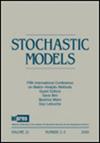Queueing with priorities and standard service: Stoppable and unstoppable servers
IF 0.7
4区 数学
Q4 STATISTICS & PROBABILITY
引用次数: 0
Abstract
Abstract We derive the mean waiting times in an M/G/1 priority queue when the decision who receives the current completed service (production) is determined at the end of the service period. We consider two variations of this scheme. The first is when the server works only when customers are present, while the second is when the server works on a nonstop basis but scraps its work if production is completed when there are no customers in line. We show that for the former variant (whose overall mean is as in the standard head-of-the-line (HOL) priority model), the gain from this scheme in comparison with the HOL case is monotone increasing with the priority level (being positive for the higher classes and negative for the lower classes).具有优先级和标准服务的队列:可停止和不可阻挡的服务器
摘要导出了M/G/1优先队列在服务周期结束时决定谁接收当前已完成的服务(生产)时的平均等待时间。我们考虑这个方案的两种变体。第一种情况是服务器只在客户在场的情况下工作,而第二种情况是服务器在不间断的基础上工作,但如果在没有客户排队的情况下完成生产,则丢弃其工作。我们表明,对于前一种变体(其总体平均值与标准的head-of- line (HOL)优先级模型一样),与HOL情况相比,该方案的增益是单调的,随着优先级的增加而增加(对于较高的类别为正,对于较低的类别为负)。
本文章由计算机程序翻译,如有差异,请以英文原文为准。
求助全文
约1分钟内获得全文
求助全文
来源期刊

Stochastic Models
数学-统计学与概率论
CiteScore
1.30
自引率
14.30%
发文量
42
审稿时长
>12 weeks
期刊介绍:
Stochastic Models publishes papers discussing the theory and applications of probability as they arise in the modeling of phenomena in the natural sciences, social sciences and technology. It presents novel contributions to mathematical theory, using structural, analytical, algorithmic or experimental approaches. In an interdisciplinary context, it discusses practical applications of stochastic models to diverse areas such as biology, computer science, telecommunications modeling, inventories and dams, reliability, storage, queueing theory, mathematical finance and operations research.
 求助内容:
求助内容: 应助结果提醒方式:
应助结果提醒方式:


